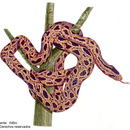en
names in breadcrumbs


Ungaliophis panamensis, or the Panamanian dwarf boa, is a species of nonvenomous snake in the family Tropidophiidae.[1] It is native to Nicaragua, Costa Rica, Panama, and Colombia.[2] Adults measure up to 50 cm (20 in) in length, with males being slightly larger but less massive than females.[3] Its diet is not entirely known, but it has been observed feeding on bats, birds and geckos.[3]
Ungaliophis panamensis, or the Panamanian dwarf boa, is a species of nonvenomous snake in the family Tropidophiidae. It is native to Nicaragua, Costa Rica, Panama, and Colombia. Adults measure up to 50 cm (20 in) in length, with males being slightly larger but less massive than females. Its diet is not entirely known, but it has been observed feeding on bats, birds and geckos.